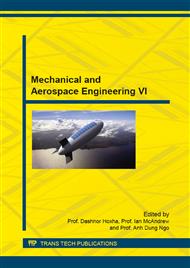[1]
P. Zhang, S. Huang: Review of Aeroelasticity for Wind Turbine: Current Status, Research Focus and Future Perspectives. Frontiers in Energy Vol. 5 (2011), No. 4, p.419 – 434.
DOI: 10.1007/s11708-011-0166-6
Google Scholar
[2]
D.H. Hodges, E.H. Dowell: Nonlinear Equations of Motion for the Elastic Bending and Torsion of Twisted Nonuniform Rotor Blades. NASA TN D-7818 (1974).
Google Scholar
[3]
D.H. Hodges, R. Ormiston: Stability of Elastic Bending and Torsion of Uniform Cantilever Rotor Blades in Hover with Variable Structural Coupling. NASA TND8192 (1976).
DOI: 10.2514/6.1973-405
Google Scholar
[4]
E. Piccione, G. Bernardini, M. Gennaretti: Structural-Aeroelastic Finite Element Modeling for Advanced-Geometry Rotor Blades. Aircr. Eng. Aerosp. Tec. Vol. 86 (2012), No. 6, pp.367-375.
DOI: 10.1108/00022661211272873
Google Scholar
[5]
L. Greco, R. Muscari, C. Testa, A. Di Mascio: Marine Propellers Performance and Flow-Field Features Prediction by a Free-Wake Panel Method. J. Hydrodyn. Ser. B Vol. 6 (2014), No. 5, p.780 – 795.
DOI: 10.1016/s1001-6058(14)60087-1
Google Scholar
[6]
M. Gennaretti, G. Bernardini: Novel Boundary Integral Formulation for Blade-Vortex Interaction Aerodynamics of Helicopter Rotors. AIAA J. Vol. 45 (2007), No. 6, p.175 – 184.
DOI: 10.2514/1.18383
Google Scholar
[7]
L. Greco, C. Testa, F. Salvatore: Design Oriented Aerodynamic Modelling of Wind Turbine Performance. J. Phys.: Conf. Series, Vol. 75 (2007), No. 1.
DOI: 10.1088/1742-6596/75/1/012011
Google Scholar
[8]
R.B. Shrinivas, G. Ranjan: Validation of Comprehensive Helicopter Aeroelastic Analysis with Experimental data. Defence Science J. Vol. 54 (2004), No. 4, p.419 – 427.
DOI: 10.14429/dsj.54.2056
Google Scholar
[9]
A. Calabretta, M. Molica Colella, L. Greco and M. Gennaretti: Assessment of Aerodynamics Models for Wind Turbines Aeroelasticity. Conf. on Advances in Civil, Environmental and Materials Research (ACEM2014). Busan, South Korea (2014).
Google Scholar
[10]
J.G. Leishman, G.L. Jr. Crouse: State-Space Model for Unsteady Airfoil Behavior and Dynamic Stall. AIAA Paper 89-1319 (1989), pp.1372-1383.
DOI: 10.2514/6.1989-1319
Google Scholar
[11]
T. Theodorsen: General Theory of Aerodynamic Instability and the Mechanism of Flutter. NACA Report 496 (1935).
Google Scholar
[12]
A. Calabretta, M. Molica Colella, L. Greco, G. Dubbioso, C. Testa and M. Gennaretti: A Comprehensive Numerical Model for Horizontal Axis Wind Turbines Aeroelasticity. Conf. on Wind Energy Science and Technology (RUZGEM2013). Ankara, Turkey (2013).
DOI: 10.1002/we.1983
Google Scholar
[13]
H. Snel, R. Houwink, J. Bosschers, W.J. Piers, G.J.W. van Bussel, A. Bruining: Sectional Prediction of 3-D Effects for Stalled Flow on Rotating Blades and Comparison with Measurements. European Community Wind Energy Conference, Lübeck-Travemünde, Germany (1993).
Google Scholar
[14]
D. L Sharpe: A Comparison of Theory and Experiment for Aeroelastic Stability of a Hingeless Rotor Model in Hover. Integrated Technology Rotor Methodology Assessment Workshop, Moffett Field (CA, USA) (1983).
Google Scholar
[15]
J. Zhang: Active-passive Hybrid Optimization of Rotor Blades with Trailing Edge Flaps. The Pennsylvania State University, PhD Thesis (2001).
Google Scholar
[16]
O.J. Kwon: A technique for the prediction of aerodynamics and aeroelasticity of rotor blades. Georgia Institute of Technology, PhD Thesis (1988).
Google Scholar
[17]
M.M. Hand, D.A. Simms, L.J. Fingersh, D.W. Jager, J.R. Cotrell, S. Schreck, S.M. Larwood: Unsteady Aerodynamics Experiment Phase VI: Wind Tunnel Test Configuration and Available Data Campaigns. NREL/TP-500-29955 (2001).
DOI: 10.2172/15000240
Google Scholar
[18]
J. Martinez, L. Bernabini, O. Probst, C. Rodriguez: An improved BEM model for the Power Curve Prediction of Stall-regulated Wind Turbines. Wind Energy Vol. 8 (2005), p.385 – 402.
DOI: 10.1002/we.147
Google Scholar


